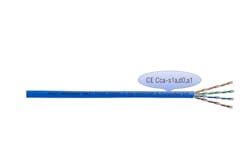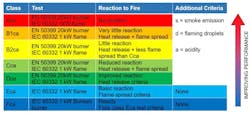By CAROL EVERETT OLIVER -- Paige’s patented GameChanger cable, the first four-pair datacom cable to perform beyond the 100-meter channel distance for Ethernet data and power (PoE), was recently launched in the United Kingdom and Europe.
To gain acceptance, this cable went through rigorous testing to earn the CE “Conformitè Europëenne” mark, which is a European marking of conformity that indicates that a product complies with the requirements of the applicable European laws. The CE label is legally required to appear on many types of products sold in specific European countries to show that they meet European health, safety and environmental standards.
Where cabling that is permanently installed in the building is concerned, the CE mark means that that a product meets the safety standards specified by the European Union Directive 305/2011 Construction Products Regulation, known as CPR. CPR was announced in the Official Journal of the European Union in 2015, which then became mandatory for cables on July, 2017.
CPR provides unified requirements for reaction to fire for power, control, communications, and optical fiber cables intended for installations in all types of construction works in all EU member states.
UL vs. CE vs. CPR
UL Listed means the product meets the standards of Underwriters Laboratories, a private safety testing organization. There are some key differences between a UL Listing and a CE Mark.
One of the biggest differences is that the UL Listing must be performed by a 3rd-party lab with approved flame and smoke tests. Another, and probably most importantly, is that cable products used in U.S. construction may not necessarily be required by law to be UL Listed, even though most contractors choose to use UL Listed products in order to avoid potential liability issues, whereas the CE Mark is mandatory by law.
A product that is already UL Listed in the U.S. doesn’t automatically qualify for the CE Mark. If a UL Listed product has also been tested to the European harmonized standards, then it may be eligible for CE certification; however, it still must receive a CE Mark and have a Declaration of Performance certificate available before it can be used in Europe. And on the flip-side, products that carry the CE Mark are not automatically considered to be UL Listed. Some product types with the CE Mark do not have to be third-party certified and are not necessarily compliant with U.S. standards.
The CPR requires the construction products, such as cables, to be assessed against a harmonized standard or have a European Technical Assessment (ETA) before the declaration can be issued and the CE marking affixed. If there are no applicable harmonized standards and the manufacturer has not requested an ETA, then the product cannot be CE marked under the CPR and as a result, cannot be sold or installed in the EU.
Steps to obtaining the CE Mark to comply to the CPR includes: identifying the applicable harmonized European standard (hEN), review the essential characteristics (which can vary depending on the specific products), undertake initial type testing and factor production controls (which might require the involvement of a Notified Body) and finally complete a Declaration of Performance and affix the CE Marking.
One critical thing to remember for both UL Listings and CE Marks is that compliancy can differ from city to city or country to country so it is key to work with the local Authority Having Jurisdiction (AHJ)
Cracking the code
The GameChanger product certified for the EU to the CPR is coded to the standard “Cca-s1a, d0, a1” So, what does that coding mean?
CPR defines several classes that indicate the impact of cables on the spread of fire, using a series of parameters obtained from the corresponding tests.
Referring to Table 1 (see below), cables are classified by seven performance classes, running from Aca to Fca, with Aca being the least reactive to fire. Additional sub-classes call out for smoke production, flaming droplets and acidity for cable classes B1ca, B2ca, Cca and Dca, as well as a more stringent, larger scale test using bundled cable.
Smoke production is rated on a sliding scale from s1a to s3, where s1 is the most demanding classification and s3 is for products where no performance is declared or which do not comply with the requirements of s1 or s2.
Flaming droplets during combustion is similarly rated from d0 to d2, where d0 is the most demanding and d2 is for products where no performance is declared or which do not comply with the requirements of d0 or d1.
Acidity is also rated on sliding scale from a1 to a3, where a1 is the most demanding criteria and a3 is for products where no performance is declared or which do not comply with the requirements of a1 or a2.
Table 1 CPR Classifications
So, let’s break it down for GameChanger’s CE Mark: Cca-s1a,d0,a1. The “Cca” rating meets a reduced flame and fire reaction as well as heat release. The “s1a” relates to the meeting the most demanding smoke protection. Regarding flame droplets, noted as “d0” for the GameChanger relates to the most demanding droplet reduction. And finally, “a1” for acidity also comes under the most demanding criteria.
In short, GameChanger cable meets the highest performing CPR rating to earn its premier CE Mark.
CAROL EVERETT OLIVER, RCDD, ESS, DCDC, is the current BICSI President-Elect and will be appointed BICSI President in 2022 and 2023. She is principal of CEO Communications in Cape Coral, FL.


